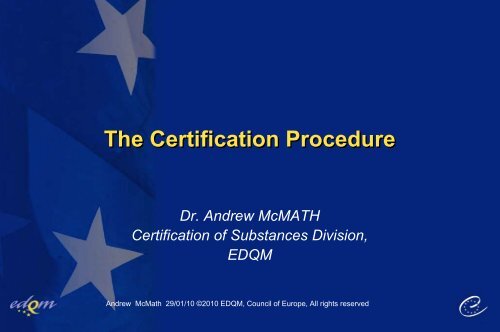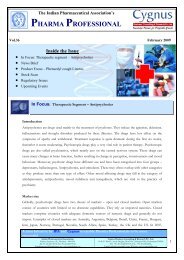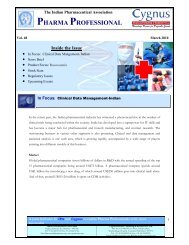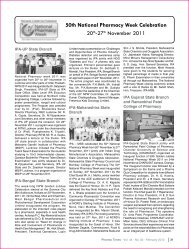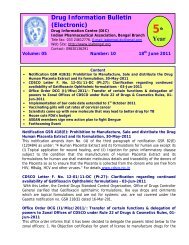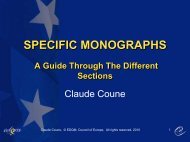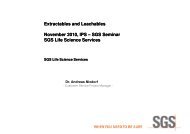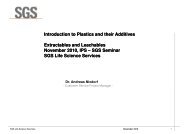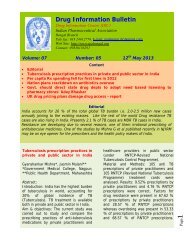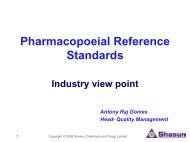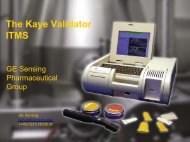Certification procedure
Certification procedure
Certification procedure
Create successful ePaper yourself
Turn your PDF publications into a flip-book with our unique Google optimized e-Paper software.
The <strong>Certification</strong> Procedure<br />
Dr. Andrew McMATH<br />
<strong>Certification</strong> of Substances Division,<br />
EDQM<br />
Andrew McMath 29/01/10 ©2010 EDQM, Council of Europe, All rights reserved
Summary<br />
• Place of <strong>Certification</strong> as a regulatory tool<br />
• Comparison of CEP & ASMF<br />
• How it works<br />
• How to read & use a CEP<br />
• Key figures<br />
• Recent developments<br />
Andrew McMath 29/01/10 ©2010 EDQM, Council of Europe, All rights reserved
Regulatory background<br />
Active substances in marketing applications :<br />
Directive 2003/63/EC and the various quality<br />
guidelines give options on how to fulfil the same<br />
basic requirements.<br />
The information required is the same regardless of the<br />
route selected (CEP or ASMF or Marketing<br />
Application)<br />
Andrew McMath 29/01/10 ©2010 EDQM, Council of Europe, All rights reserved
NfG CHMP/QWP/297/97 rev. 1 corr<br />
«Summary of requirements for active substances<br />
in the quality part of the dossier»<br />
This document describes how to communicate the<br />
information on the active substance (API) to authorities in<br />
Europe.<br />
It gives three choices:<br />
2.1 Certificate of suitability<br />
2.2 Active Substance Master File (ASMF)<br />
2.3 Full details of manufacture<br />
Andrew McMath 29/01/10 ©2010 EDQM, Council of Europe, All rights reserved
NfG CHMP/QWP/297/97 rev. 1 corr<br />
“Summary of requirements for active substances<br />
in the quality part of the dossier”<br />
2.1 Certificate of suitability<br />
Since this <strong>procedure</strong> requires a Ph. Eur. monograph, it is used for<br />
existing substances and the guideline states : “ where applicable,<br />
option 2.1 has the advantage of generally avoiding any<br />
subsequent reassessment ”<br />
2.2 Active substance Master File (ASMF)<br />
2.3 Full details of manufacture in licence application<br />
Since these <strong>procedure</strong>s do not require a Ph. Eur. monograph they<br />
can be used for new substances;<br />
but may also be used for existing substances.<br />
Andrew McMath 29/01/10 ©2010 EDQM, Council of Europe, All rights reserved
Differences between CEP & ASMF<br />
- Scope:<br />
•CEP: pharmacopoeial substances only,<br />
-> active subst. or excipient<br />
• ASMF : active substances only,<br />
-> new or pharmacopoeial<br />
Andrew McMath 29/01/10 ©2010 EDQM, Council of Europe, All rights reserved
Differences between CEP & ASMF<br />
- Specificity of ASMF:<br />
• Full dossier sent by API manufacturer to National Authorities<br />
• Applicant’s part sent by API manufacturer to MA applicant or<br />
holder of medicinal Product<br />
• Letter of access (to be sent by API manufacturer)<br />
• Assessment of ASMF by each national authority in the<br />
context of assessing a specific marketing authorisation<br />
application or variation for medicinal products<br />
Andrew McMath 29/01/10 ©2010 EDQM, Council of Europe, All rights reserved
Differences between CEP & ASMF<br />
- Specificity of CEP <strong>procedure</strong>:<br />
• Full dossier sent directly by manufacturer to EDQM<br />
• Single evaluation centralised at EDQM<br />
• By assessors nominated by national authorities /<br />
<strong>Certification</strong> Steering Committee<br />
• Independent from marketing applications of medicinal<br />
products<br />
• Certificate including annexes (additional tests to be<br />
performed) granted to manufacturer who supplies a copy<br />
of it to its users<br />
Andrew McMath 29/01/10 ©2010 EDQM, Council of Europe, All rights reserved
Advantages of the CEP<br />
Provides:<br />
• Easier management of RA documentation for API<br />
manufacturer (no open part)<br />
• Savings of time and resources<br />
• Easier management of MAA - replaces main part of<br />
3.2.S<br />
• CEP accepted in all Ph. Eur. Member states (36) +<br />
others (eg. Canada (MoU 03/2007), Australia,<br />
Morocco, New Zealand etc.)<br />
Andrew McMath 29/01/10 ©2010 EDQM, Council of Europe, All rights reserved
Useful background<br />
• Resolution AP-CSP(07) 1 of the CoE:<br />
Describes the process for the <strong>Certification</strong><br />
<strong>procedure</strong><br />
• Content of the (CEP) dossier<br />
PA/PH/CEP (04) 1, 4R<br />
Both available on EDQM website<br />
Andrew McMath 29/01/10 ©2010 EDQM, Council of Europe, All rights reserved
Useful background<br />
• Notes for guidance (ICH + CHMP/CVMP) apply, in<br />
particular:<br />
• Impurities testing (ICH Q3A + Ph. Eur. General Monograph 2034,<br />
Substances for Pharmaceutical Use)<br />
• Solvents (ICH Q3C = Ph. Eur. general text 5.4 )<br />
• Specifications limits for residues of metal catalysts or metal<br />
reagents (CHMP/SWP)<br />
• Limits of genotoxic impurities (CHMP-SWP)<br />
• (Stability testing (ICH Q1 + CHMP guidelines for existing<br />
substances.)<br />
• GMP (ICH Q7, Annex 1 to EU GMP)<br />
• TSE (CPMP/CVMP guideline = PhEur general text 5.2.8)<br />
Andrew McMath 29/01/10 ©2010 EDQM, Council of Europe, All rights reserved
Scope of the <strong>Certification</strong> <strong>procedure</strong><br />
- Substances described in monographs in the Ph. Eur.:<br />
Active substances, excipients, herbal drugs / herbal<br />
preparations “Chemical” CEP<br />
- Products with risk of TSE (SM, intermediates, reagents,..) <br />
“TSE “CEP<br />
- Substances described in monographs in the Ph. Eur.and<br />
with risk of TSE “Double “CEP<br />
Open to any manufacturer<br />
regardless of geographical<br />
origin<br />
Andrew McMath 29/01/10 ©2010 EDQM, Council of Europe, All rights reserved
Out of Scope of the <strong>Certification</strong><br />
<strong>procedure</strong><br />
- Substances not included in Ph. Eur.<br />
- Biologicals<br />
- Human tissues derivatives, blood derivatives,<br />
vaccines<br />
- Finished products<br />
Andrew McMath 29/01/10 ©2010 EDQM, Council of Europe, All rights reserved
<strong>Certification</strong>: organisation<br />
• Steering Committee<br />
• Technical Advisory Boards (TAB)<br />
Chemical<br />
TSE<br />
Herbals<br />
• Assessors<br />
• EDQM <strong>Certification</strong> Division<br />
Andrew McMath 29/01/10 ©2010 EDQM, Council of Europe, All rights reserved
Steering Committee<br />
• Representatives of main regulatory bodies (14 members<br />
from EMA WP, EU Commission, Ph. Eur Commission,<br />
Non-EU licensing authorities,...)<br />
• Monitoring <strong>Certification</strong> <strong>procedure</strong><br />
• Appointment of assessors<br />
• Appointment of Technical Advisory Boards (TABs) and<br />
their Chairperson<br />
• Policy adoption<br />
• Review and comment on issues raised by TABs<br />
• Co-ordination of issues between the represented parties<br />
Andrew McMath 29/01/10 ©2010 EDQM, Council of Europe, All rights reserved
Technical advisory boards (TAB)<br />
• Consists of experienced assessors involved in the CEP<br />
<strong>procedure</strong> for a period of time<br />
Role:<br />
• To assist assessors in case of doubt or disagreement<br />
• To prepare technical guidance<br />
• To identify technical/scientific problems and seek advice<br />
for SC<br />
Andrew McMath 29/01/10 ©2010 EDQM, Council of Europe, All rights reserved
Assessors and <strong>Certification</strong> Division<br />
A<br />
• Assessors appointed by agencies<br />
(about 80 from 16 countries)<br />
– Role : evaluation of dossiers<br />
1<br />
1<br />
2<br />
1<br />
5<br />
8<br />
10<br />
5 2<br />
7<br />
5<br />
3<br />
3<br />
5 4<br />
19<br />
B<br />
CH<br />
CND<br />
D<br />
DK<br />
E<br />
F<br />
IE<br />
IT<br />
H<br />
NL<br />
P<br />
UK<br />
S<br />
SF<br />
• <strong>Certification</strong> Division<br />
(EDQM scientific and administrative staff )<br />
– Role : execution of the <strong>procedure</strong> and co-ordination<br />
Andrew McMath 29/01/10 ©2010 EDQM, Council of Europe, All rights reserved
Content of the dossier:<br />
For details Nathalie Vicente<br />
Andrew McMath 29/01/10 ©2010 EDQM, Council of Europe, All rights reserved
How it works:<br />
Application<br />
Up-dating :<br />
- at any change (minor/major)<br />
- After 5 years (renewal)<br />
Request for<br />
inspection<br />
Revision of<br />
monograph<br />
Transfer to EDQM<br />
experts group<br />
Validation<br />
Evaluation (2 assessors)<br />
+ TAB if necessary<br />
CEP granted<br />
Possibility<br />
of hearing<br />
Request for add info<br />
refusal<br />
Info of<br />
licensing auth.<br />
Andrew McMath 29/01/10 ©2010 EDQM, Council of Europe, All rights reserved
How long does it take?<br />
• Timeframes:<br />
– Applicant notified by EDQM on the assessment<br />
conclusion within 5 months of receipt of new dossier,<br />
once validated<br />
– Responses from applicant expected within 6 months<br />
for original demand<br />
– Responses assessed within 4 months<br />
NB. Since 1/09/2008: strict <strong>procedure</strong> applied - only one<br />
request for additional information<br />
Andrew McMath 29/01/10 ©2010 EDQM, Council of Europe, All rights reserved
HOW TO READ A CEP<br />
Andrew McMath 29/01/10 ©2010 EDQM, Council of Europe, All rights reserved
The certificate of suitability, chemical:<br />
• Certifies that the quality of a given substance can<br />
be suitably controlled by the Ph.Eur. monograph -<br />
with additional tests if necessary (stated on the<br />
CEP).<br />
• It DOES NOT certify that a batch or batches of the<br />
substance complies with the Pharmacopoeia<br />
monograph.<br />
• It IS NOT a GMP certificate<br />
Andrew McMath 29/01/10 ©2010 EDQM, Council of Europe, All rights reserved
The CEP, TSE :<br />
• Certifies that the substance complies with the<br />
EMEA NfG on minimising the TSE risk<br />
• It DOES NOT certify that the quality of the<br />
substance can be suitably controlled by the Ph.Eur.<br />
monograph<br />
• It DOES NOT certify that a batch of the substance<br />
complies with the monograph<br />
• It IS NOT a GMP certificate<br />
Andrew McMath 29/01/10 ©2010 EDQM, Council of Europe, All rights reserved
All CEPs specify:<br />
• Unique Reference number<br />
(e.g. R0-CEP 2000-001-Rev01)<br />
• Title: clear definition of the substance<br />
+ grade when requested (eg. micronised, sterile,…)<br />
• Holder + manufacturing site(s)<br />
• Monograph(s) concerned<br />
• Starting validity date<br />
• Line numbering and annex details if appropriate<br />
Andrew McMath 29/01/10 ©2010 EDQM, Council of Europe, All rights reserved
And as necessary, chemical CEPs:<br />
• Additional impurities/Solvents/Catalysts<br />
– With limits and methods<br />
• Re-test period<br />
– With storage conditions + container<br />
• Specs (limit + test) for a specific grade<br />
• Tests of the monograph which can be omitted<br />
• Use or non-use of materials of animal origin<br />
Andrew McMath 29/01/10 ©2010 EDQM, Council of Europe, All rights reserved
And if for a sterile material:<br />
• Description of sterilisation method and<br />
container/closure<br />
• Statement that the validation of the sterilisation has<br />
been evaluated<br />
NB: the information on the sterilisation process and its<br />
validation needs to be submitted separately in the<br />
marketing authorisation dossier<br />
Andrew McMath 29/01/10 ©2010 EDQM, Council of Europe, All rights reserved
And for a TSE certificate:<br />
• Country(ies) of origin of animals<br />
• Animal and nature of tissue(s) used<br />
• Manufacturing process applied (when relevant,<br />
e.g. gelatins)<br />
• Quality assurance system applied<br />
Andrew McMath 29/01/10 ©2010 EDQM, Council of Europe, All rights reserved
The CEP looks like:<br />
Andrew McMath 29/01/10 ©2010 EDQM, Council of Europe, All rights reserved
How to use a CEP:<br />
Andrew McMath 29/01/10 ©2010 EDQM, Council of Europe, All rights reserved
What should be addressed at the level<br />
of the MAA ?<br />
• Stability if no re-test period mentioned on the CEP<br />
• All data relating to physico-chemical characteristics<br />
(e.g. particle size) if no grade claimed<br />
• Assessment is performed taking into account the<br />
general use of the substance. Specific uses should<br />
be addressed at the level of the marketing<br />
authorisation application<br />
Andrew McMath 29/01/10 ©2010 EDQM, Council of Europe, All rights reserved
KEY FIGURES<br />
Andrew McMath 29/01/10 ©2010 EDQM, Council of Europe, All rights reserved
Certificates of Suitability<br />
• > 4000 applications since <strong>procedure</strong> launched<br />
• ~ 2500 valid certificates<br />
• > 760 substance monographs involved<br />
• …<br />
Andrew McMath 29/01/10 ©2010 EDQM, Council of Europe, All rights reserved
Certificates of Suitability<br />
… > 560 manufacturers from 43 countries<br />
Repartition of manufacturing sites covered by CEPs (2008)<br />
America<br />
15%<br />
Middle East<br />
1% Africa<br />
Pacific zone<br />
1%<br />
4%<br />
Europe<br />
41%<br />
Asia<br />
38%<br />
Andrew McMath 29/01/10 ©2010 EDQM, Council of Europe, All rights reserved
RECENT DEVELOPMENTS<br />
Andrew McMath 29/01/10 ©2010 EDQM, Council of Europe, All rights reserved
Recent developments<br />
1. New <strong>procedure</strong> for the assessment of “sister files”<br />
when a manufacturer has been granted a CEP for a<br />
substance and where they apply for a second CEP for the<br />
same substance to cover an alternative process, generally<br />
because the existing one cannot cover the new<br />
process/conditions,<br />
fast track <strong>procedure</strong> focusing the evaluation on the<br />
variations compared to the approved CEP dossier.<br />
(see EDQM web-site PA/PH/CEP (09) 141).<br />
Andrew McMath 29/01/10 ©2010 EDQM, Council of Europe, All rights reserved
Recent developments<br />
2. Revision of general monograph 2034 Substances for<br />
Pharmaceutical Use:<br />
- New limits for synthetic peptides:<br />
- Updated limits for substance for vet. use only<br />
- Published in Supplement 6.5<br />
- Implemented on 1 July 2009<br />
Andrew McMath 29/01/10 ©2010 EDQM, Council of Europe, All rights reserved
Recent developments<br />
3. Substances extracted from animal tissues:<br />
(heparin, enoxaparin, …), the t EDQM no longer accepts<br />
any new application for a CEP for biological substances.<br />
See <strong>Certification</strong> website / New Applications<br />
- A list of these biological products is available on the<br />
CMD(h) web-sitehttp://www.hma.eu/uploads/media/070618.pdf<br />
Andrew McMath 29/01/10 ©2010 EDQM, Council of Europe, All rights reserved
<strong>Certification</strong>: benefits<br />
• Single & harmonised assessment<br />
• Replaces Active Substance Master File<br />
• Savings of time and resources<br />
• Updating of monographs (impurities)<br />
• Revision of monographs (new or replacement test<br />
methods)<br />
• CEPs are recognised in Europe and beyond<br />
Andrew McMath 29/01/10 ©2010 EDQM, Council of Europe, All rights reserved
Thank you ! ☺<br />
Andrew McMath 29/01/10 ©2010 EDQM, Council of Europe, All rights reserved


